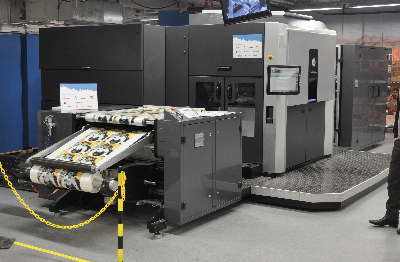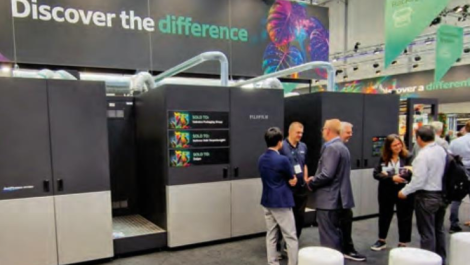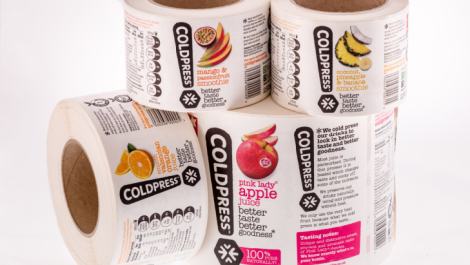DL&P visited the Israel headquarters of HP to see first hand the developments it will be showing at drupa. There are plenty of significant offerings for digital packaging and labels.
The highlights of HP’s offering are the new family of B2 Indigo presses, two of which will be firmly aimed at packaging and the announcement that the high end flatbed inkjet machines from HP Scitex will target corrugated packaging as a growing market segment. There are also some improvements to the existing WS6600 label press that was first shown at Labelexpo last September. The priming material for films will be available after drupa and this will significantly broaden the applications for the machine as more substrates can be used, including many standard label stocks. The enhanced productivity mode launched on the WS6600 will be offered across other machines. This uses colour management to switch four colour process to three, removing the black. This increases the speed while reducing the number of clicks, so providing two major benefits for customers.
Moving into B2
The headlines at the event, however, were grabbed by the new Series 4 B2 format presses. Pricing has not been finally announced but it is likely that the overall cost of printing will be lower than on other presses, provided the volumes are sufficiently large. Indigo believes it will be successful, with Alon Bar Shany, Indigo’s general manager, saying these developments are firmly targeted at ‘the heart of offset’.
There are several advantages through the larger format. Much improved productivity is the big one, while the larger format opens new applications. The 10000 press will be the first to come to the market later this year. It has maximum sheet size of 750 x 530 mm, with imaging area of 749 x 510 mm, some 250% larger than the existing sheetfed machine. Speed is 3450 sheets per hour in process colour (230 x A4 pages per minute) and a third higher in EPM on paper and board between 65 and 450 g/m2.
There are quality boosts with in line densitometry, a scanning spectrophotometer and total camera inspection system for each sheet. It is ergonomically designed with two touch screen control panels, one at the front and the other by the rear ink cabinet. The same ElectroInk is used as other presses, but it is more concentrated supplied in larger 4.5 kg cans that are diluted with the mineral oil in the press. Ink conductivity is continuously monitored to maintain consistent print quality. There is a pallet feeder and two paper trays, with an optional further two trays allowing multiple substrates to be used, or for continuous feed. It is a long edge totally automated feed; users load sheets into the feeders and the system does the rest, even for offset stacks. Paper handling is improved with blowers in the trays to fan sheets, the Tornado friction feed with vacuum. There is a double sheet detector into a divert, then aligning to the front lays, centred and passed to the grippers that are more flexible than in offset as different colour combinations mean different sheet throughput. The print unit is much bigger, weighing 11 tonnes with a three tonne frame to minimise vibration and provide print stability. The print unit is scaled up from the previous model, with faster mechanical speed. The larger plates and blankets can be automatically replaced in a quicker cycle requiring less operator skill.
The 10000 is aimed at commercial print but as with other Indigo presses there will be derivatives. The first two are the 20000, a web version for flexible packaging, and the sheetfed 30000 for cartons. There are several significant differences with the 10000. They are both single sided printing. Each has an in line priming station to broaden the range of substrates with Corona discharge, and the imaging is a single shot process to improve registration on a wide range of stocks. Each separation is passed onto the blanket then transferred to the substrate in a single pass, maintaining registration even onto lightweight unsupported films and heat sensitive materials.
The web fed Indigo 20000 is aimed at flexible packaging, with a web width of 760 mm and speed of 34 metres per minute in four colour mode, rising to almost 45 metres per minute in EPM mode but additional colours cause throughput to fall. Image size is a maximum 736 mm wide with a repeat of 1089 mm, on substrates from two to 25 microns. There is Corona treatment in an in line priming unit, applying coatings to improve adhesion onto either paper or film substrates – PE, PET, BOPP, CPP, PA, PVC and OPS, and aluminium foil. This allows most standard stocks to be printed and should be economic against flexo for runs of 15 to 18,000 linear metres, which covers a large proportion of the market.
The 30000 carton machine handles thicker board up to 600 microns, together with foils and plastics. It also has a priming station so making foils and plastics printable and there will be a final coating system launched at drupa providing UV and aqueous coating with easy glue flap free functionality. Although not yet available Indigo is working with partners such as Highcon and Scodix to provide a total carton production line. The ElectroInk complies with many food packaging regulations in Europe and the United States for non-food contact including the Swiss Ordinance and Nestlé Guidance Note on Packaging Inks for indirect food contact.
These machines will come to the market later, in early 2013. the company believes these platforms will open new opportunities in packaging, helping change of mindset for converters. They will open up short to medium runs, for flexibles this is new as there is currently no solution. Forward thinking converters will move the purchasing conversation toward marketing, helping to grow a brand, rather than a typical cost exercise with purchasing.
Wide format
HP is a major player in wide and grand format and very high performance flatbed FB7600 models from Scitex. There are six colours, plus a new white and optional full stack to stack automation option using a mechanical unloader from German company Hostert for high productivity. HP is a leader in wide format inkjet selling over 10,000 machines using the water based latex inks and it has many UV curing systems in operation. It estimates that a third of the signage market is now digital with two thirds of the large format screen moved to inkjet and it is now firmly attacking large format offset, and eyeing up packaging as a new large growing market. Many of the Scitex users produce corrugated point of sale and displays and the growth of secondary shelf ready packs means that inkjet has a significant share already and that is growing.
So, the company has a lot of exciting developments that will be launched at drupa. Its resources mean that the next series of developments are already underway. It aborted the first B2 concept back in 2002, this version is totally new. The current project started in 2008, employing some 400 people looking at all aspects of the machine. Although there was firmly no comment, it is likely that the B1 version will soon join the market if the B2 is successful, no doubt with further speed improvements. The blanket is already big enough (the maximum imaging area on the 20000 press is 1089 x 736 mm, already larger than B1), the wider leading edge means feeding a B1 sheet should be possible in the existing engine. The inherent scalability of the inkjet presses means steady improvements will be continually released, and HP is supporting existing users by providing a field upgrade option to the new specification where the format is unchanged.






